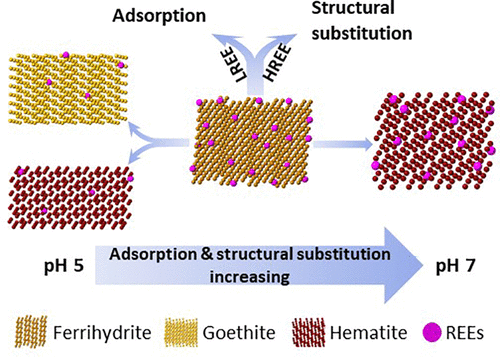当前位置:
X-MOL 学术
›
ACS Earth Space Chem.
›
论文详情
Our official English website, www.x-mol.net, welcomes your
feedback! (Note: you will need to create a separate account there.)
Ferrihydrite Transformation Impacted by Adsorption and Structural Incorporation of Rare Earth Elements
ACS Earth and Space Chemistry ( IF 2.9 ) Pub Date : 2021-09-14 , DOI: 10.1021/acsearthspacechem.1c00159 Meijun Yang 1, 2 , Xiaoliang Liang 1, 2, 3 , Ying Li 4 , Hongping He 1, 2, 3 , Runliang Zhu 1, 2, 3 , Yuji Arai 4
ACS Earth and Space Chemistry ( IF 2.9 ) Pub Date : 2021-09-14 , DOI: 10.1021/acsearthspacechem.1c00159 Meijun Yang 1, 2 , Xiaoliang Liang 1, 2, 3 , Ying Li 4 , Hongping He 1, 2, 3 , Runliang Zhu 1, 2, 3 , Yuji Arai 4
Affiliation

|
Understanding the association of rare earth elements (REEs) with iron (oxyhydr)oxides is of great interest in the recovery of REEs from regolith and weathered soils in the world. The objective of this study was to understand the effects of 1 mg L–1 REEs on the ferrihydrite transformation process. Ferrihydrite was synthesized at pH 5 and 7 in the presence of REEs, and the transformation products were characterized using X-ray diffraction, Fe K-edge X-ray absorption spectroscopy, and transmission electron microscopy. During the phase transformation process after 60–120 days, the retention of REEs varied with the REE atomic number. In general, heavy REEs preferably partitioned in aged (≥90 days) ferrihydrite more than light REEs, especially at pH 5. At pH 5, the transformation of ferrihydrite to goethite was retarded by ∼12% when REEs were present. The average structural substitution of REEs was as high as ∼550 mg kg–1, and the substitution of heavy REEs such as Yb and Lu was a critical factor to suppress the ferrihydrite transformation. At pH 7, the formation of hematite was retarded by ∼10%, and the structural incorporation of REEs was more important than adsorbed REEs during the first 30 days. There was no REE-specific retention in aged iron (oxyhydr)oxides at pH 7. The results of this study may explain the association of REEs with iron (oxyhydr)oxides, especially heavy REEs in mildly acidic regolith and weathered soils. This study advanced our understanding of the aqueous geochemical behavior of REEs in iron (oxyhydr)oxide-rich supergene environments.
中文翻译:

稀土元素吸附和结构掺入对水铁矿转变的影响
了解稀土元素 (REE) 与铁(羟基)氧化物的关联对于从世界风化土和风化土壤中回收 REE 具有重要意义。本研究的目的是了解 1 mg L –1稀土元素对水铁矿转变过程的影响。在 REE 存在下,在 pH 5 和 7 下合成了水铁矿,并使用 X 射线衍射、Fe K 边 X 射线吸收光谱和透射电子显微镜表征了转化产物。在 60-120 天后的相变过程中,REE 的保留率随 REE 原子序数的变化而变化。一般来说,重 REE 比轻 REE 更倾向于分配在老化(≥90 天)的水铁矿中,尤其是在 pH 5 时。在 pH 5 时,当 REE 存在时,水铁矿向针铁矿的转变被延迟了约 12%。REE 的平均结构取代度高达 ~550 mg kg –1, 重稀土元素如 Yb 和 Lu 的取代是抑制水铁矿转变的关键因素。在 pH 值为 7 时,赤铁矿的形成延迟了约 10%,并且在前 30 天内,REE 的结构掺入比吸附的 REE 更重要。在 pH 7 时,老化的铁(羟基)氧化物中没有 REE 特异性保留。本研究的结果可以解释 REE 与铁(羟基)氧化物的关联,尤其是弱酸性风化土和风化土壤中的重 REE。这项研究加深了我们对富含铁(羟基)氧化物表生环境中 REE 的水相地球化学行为的理解。
更新日期:2021-10-22
中文翻译:

稀土元素吸附和结构掺入对水铁矿转变的影响
了解稀土元素 (REE) 与铁(羟基)氧化物的关联对于从世界风化土和风化土壤中回收 REE 具有重要意义。本研究的目的是了解 1 mg L –1稀土元素对水铁矿转变过程的影响。在 REE 存在下,在 pH 5 和 7 下合成了水铁矿,并使用 X 射线衍射、Fe K 边 X 射线吸收光谱和透射电子显微镜表征了转化产物。在 60-120 天后的相变过程中,REE 的保留率随 REE 原子序数的变化而变化。一般来说,重 REE 比轻 REE 更倾向于分配在老化(≥90 天)的水铁矿中,尤其是在 pH 5 时。在 pH 5 时,当 REE 存在时,水铁矿向针铁矿的转变被延迟了约 12%。REE 的平均结构取代度高达 ~550 mg kg –1, 重稀土元素如 Yb 和 Lu 的取代是抑制水铁矿转变的关键因素。在 pH 值为 7 时,赤铁矿的形成延迟了约 10%,并且在前 30 天内,REE 的结构掺入比吸附的 REE 更重要。在 pH 7 时,老化的铁(羟基)氧化物中没有 REE 特异性保留。本研究的结果可以解释 REE 与铁(羟基)氧化物的关联,尤其是弱酸性风化土和风化土壤中的重 REE。这项研究加深了我们对富含铁(羟基)氧化物表生环境中 REE 的水相地球化学行为的理解。











































 京公网安备 11010802027423号
京公网安备 11010802027423号